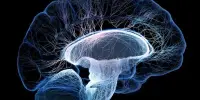Alzheimer’s, Parkinson’s, and other neurological disorders are characterized as “dirty brain” diseases, in which the brain struggles to eliminate dangerous waste. Aging is a significant risk factor since our brain’s ability to eliminate toxic accumulation declines with age. However, new research in mice shows that it is feasible to reverse age-related impairments and restore the brain’s waste-clearing mechanism.
“This research shows that restoring cervical lymph vessel function can substantially rescue the slower removal of waste from the brain associated with age,” said Douglas Kelley, PhD, a professor of Mechanical Engineering in the University of Rochester Hajim School of Engineering and Applied Sciences. “Moreover, this was accomplished with a drug already being used clinically, offering a potential treatment strategy.” Kelley is one of the lead authors of the study, which appears in the journal Nature Aging, along with Maiken Nedergaard, MD, DMSc, co-director the University’s Center for Translational Neuromedicine.
The glymphatic system, first discovered by Nedergaard and colleagues in 2012, is the brain’s unique waste elimination process that uses cerebrospinal fluid (CSF) to wash away surplus proteins produced by energy-hungry neurons and other brain cells during normal activity. This discovery paved the path for potential new treatments for disorders associated with the accumulation of protein waste in the brain, such as Alzheimer’s (beta amyloid and tau) and Parkinson’s (alpha-synuclein). In healthy and youthful brains, the glymphatic system performs an excellent job of washing out these hazardous proteins; however, as we age, this system declines, laying the groundwork for various disorders.
This research shows that restoring cervical lymph vessel function can substantially rescue the slower removal of waste from the brain associated with age. Moreover, this was accomplished with a drug already being used clinically, offering a potential treatment strategy.
Douglas Kelley
A network of tiny pumps draws waste from the brain
Once laden with protein waste, CSF in the skull needs to make its way to the lymphatic system and ultimately the kidneys, where it is processed along with the body’s other waste. The new research combines advanced imaging and particle tracking techniques to describe for the first time in detail the route via the cervical lymph vessels in the neck through which half of dirty CSF exits the brain.
In addition to measuring the flow of CSF, the researchers observed and recorded the pulsing of lymph arteries in the neck, which aids in the removal of CSF from the brain. “Unlike the cardiovascular system which has one big pump, the heart, fluid in the lymphatic system is instead transported by a network of tiny pumps,” according to Kelley. Lymphangions are microscopic pumps with valves that prevent backflow and are strung together to produce lymph vessels.
The researchers discovered that as the mice matured, the number of contractions dropped and the valves collapsed. As a result, the movement of unclean CSF from aged mice’s brains was 63 percent slower than that of younger animals.

Known drug restarts flow of brain cleaning fluids
The team then set out to see if they could revive the lymphangions and identified a drug called prostaglandin F2α, a hormone-like compound commonly used medically to induce labor and known to aid smooth muscle contraction. The lymphangions are lined with smooth muscle cells, and when the researchers applied the drug to the cervical lymph vessels in older mice, the frequency of contractions and the flow of dirty CSF from the brain both increased, returning to a level of efficiency found in younger mice.
Scientists have been exploring various methods to enhance this waste disposal system. Techniques might include targeting specific pathways to boost autophagy, using drugs or lifestyle interventions like diet and exercise, or even employing gene therapy.
“These vessels are conveniently located near the surface of the skin, we know they are important, and we now know how to accelerate function,” said Kelley. “One can see how this approach, perhaps combined with other interventions, could be the basis for future therapies for these diseases.”
















